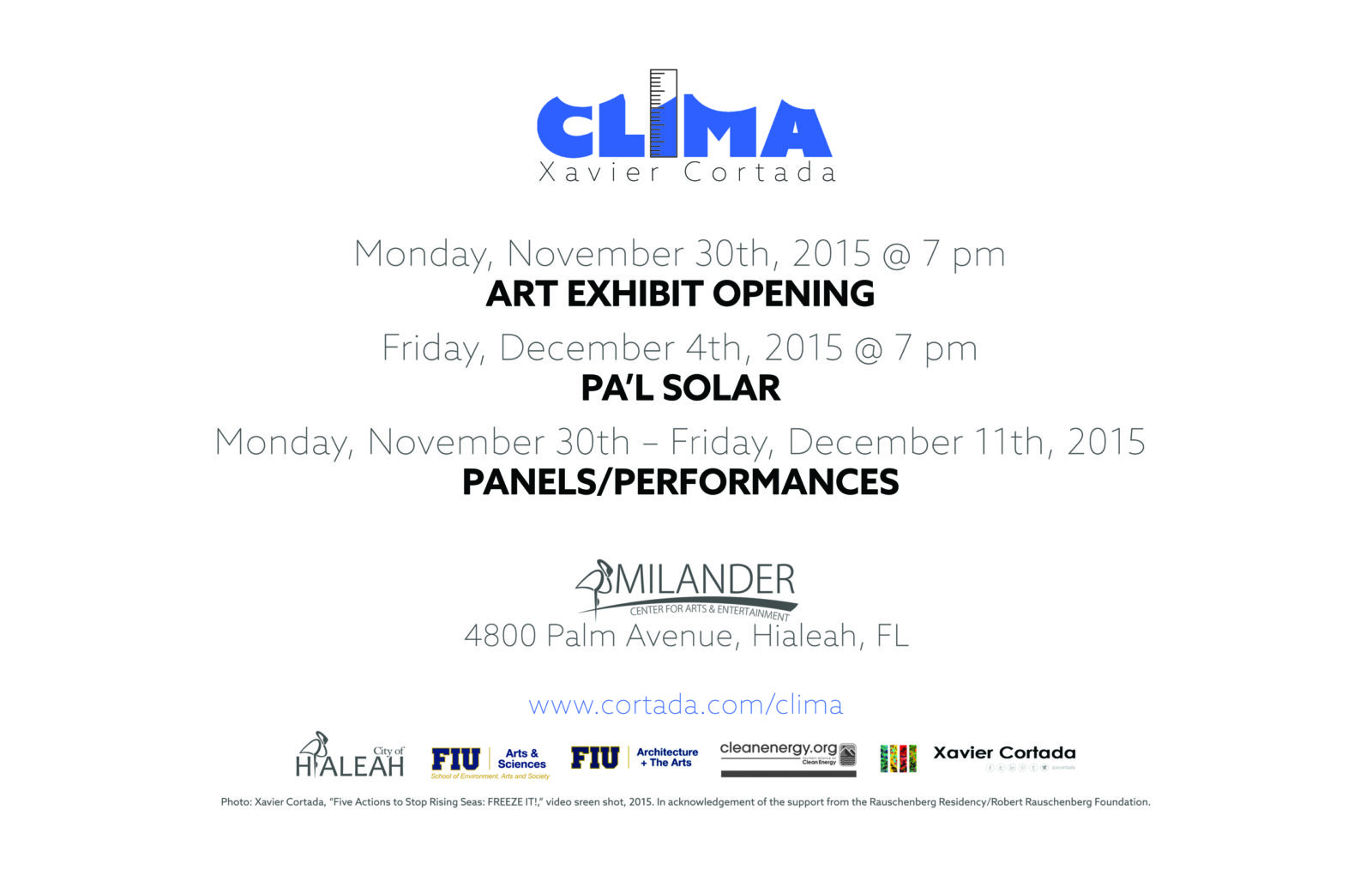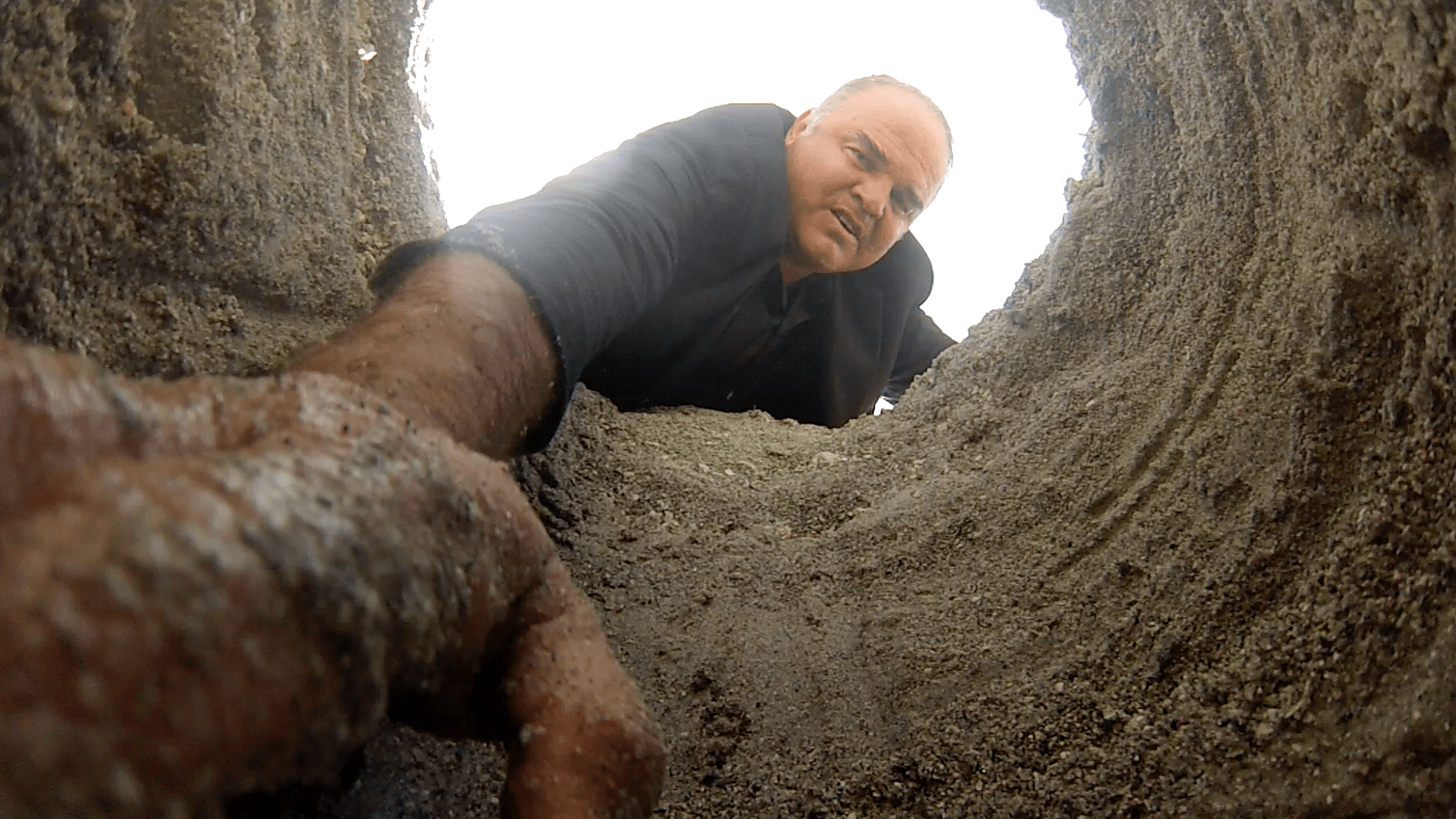
- This event has passed.
CLIMA Events
November 30, 2015 - January 29, 2016

Main | Main 2015 | Statement | Gallery | Press | Events | Livestream

Xavier Cortada, “5 Actions to Stop Rising Seas: Bury it!,” video screen shot, 2015.
In acknowledgement of the support from the Rauschenberg Residency/Robert Rauschenberg Foundation.
OPENING RECEPTION:
Join us at 7 pm on November 30th for the exhibit opening and the screening of Cortada’s Five Actions to Stop Sea Level Rise film!
PANELS / PERFORMANCES
Monday, November 30th – Friday, December 11, 2015
The panels will be will be streamed live (www.cortada.com/clima/livestream).
CLOSING RECEPTION:
Join us at 6 pm on January 28th for the closing reception of Xavier Cortada’s CLIMA exhibit!
at
Milander Center for Arts & Entertainment
4800 Palm Avenue, Hialeah, FL
The daily panels will coincide with the
and address global climate concerns.
During this time period Cortada will also be painting related images directly onto three solar panels onsite.
MONDAY NOVEMBER 30
6 pm panel | 7 pm opening reception
5 Actions to Stop Rising Seas film screening | Melt | WAIST Line
Sea Level Rise in Hialeah
What causes sea level rise? How will sea level rise impact Hialeah? What can be done now to prepare?
Opening Reception and Film Screening:
Film screening of Cortada’s 5 Actions to Stop Rising Seas (created during the artist’s participation in the Robert Rauschenberg Residency Rising Seas Confab 2015)
WAIST (Western Antarctic Ice Sheet Threat) Line: Using the “Eyes on the Rise” app, participants will determine their homes’ elevation, find out what the impact melting glaciers will have on their property. They will be use a blue tape to mark the WAIST (Western Antarctic Ice Sheet Threat) Line on their home. They’ll bring photo’s of their homes’ WAIST Line of the exhibit.
Melt: Blocks of ice will melt at the steps of the Milander Center for Arts and Entertainment.
TUESDAY DECEMBER 1
10 am panel | Awash video | Afloat
Underwater?
Policy makers, economists, lawyers and realtors will discuss the impacts on property values and tax base as sea levels rise. How will society confront increasing infrastructure costs (e.g., desalination plants, water pumps) as the tax base decreases?
Awash: Video by Xavier Cortada (created during the artist’s participation in the Robert Rauschenberg Residency Rising Seas Confab 2015)
Afloat: Participants will bring a print out of their property record (download here) and make paper boats and float them in the interior fountain.
WEDNESDAY DECEMBER 2
10 am panel | Eat it video
(Un)Healthy World
What are the implications of global climate change on human health? The panel will discuss how environmental changes can lead to the rise of infectious diseases and alterations in the microbiome that directly affect the health of humans, animals, crops and other plants. The panel will also discuss the positive effects of nature on the human psyche and the mental health challenges brought about by environmental degradation and loss.
EnvironMental Therapy Session: Participants will engage in a group therapy session to address grief due to their (environmental) loss and focus on cognitive behavior responses to confront their daily challenges.
THURSDAY DECEMBER 3
10 am panel | Freeze it video
Green Generation
How are future scientists, engineers, architects, and other thinkers going to innovate new technologies and find creative ways to bring solar power, wind energy and new efficiencies into the mainstream of American life? How are our schools, universities, and cultural institutions educating our future generation.
The Creative Cube: Participants will think outside the “box.” They will then turn the box inside out and make it into a sphere.
FRIDAY DECEMBER 4
10 am panel | Clean Coal video
7 pm party
Powering the Sunshine State
What is the status of Solar Energy in Florida? What is the Solar Ballot Initiative about? What impact would widespread use of solar energy have on our state’s economy and climate? What opportunities does clean energy bring for cost savings and job creation?
Clean Coal: There is no such thing as Clean Coal video.
Solaring: Participants will come soak in sun rays at exhibit. (Note: Cabana boy will be available with sun tan lotions)
(Tirandonos) pa’l Solar (7 pm):
A party celebrating Solar Choices and Art Basel week, including live music, a Solar Petition Conga Line, and Solar fashion show featuring designs by Lea Nickless. The event will feature Cortada’s:
SOLAR, a triptych on three solar panels in support of a ballot initiative proposed by Floridians for Solar Choice (see https://cortada.com/events/
Painting a Brighter Future: a political/environmental performance art project, and
Sky high: a participatory art project where participants will bring their FPL bill to make and fly paper airplanes — seeing if they can make them soar as high as their fossil fuel based utility rates.
SATURDAY DECEMBER 5
10 am panel | Wilderness Wake video
Waning wilderness
How are climate change, habitat destruction and introduction of exotic invasive species changing the ecology of South Florida? What do we have to do proactively to protect our ecosystem, restore native habitats and protect our biodiversity?
Wilderness Wake: Eulogy and memorial service for the end of the wilderness.
The Sacrifice:
Participants, including members of the Faith community, will come together in a circle and engage in an altogether different type of animal sacrifice. Their offerings will be for animals struggling to survive across each of the Earth’s 360 longitudes. One by one they will speak the names of 360 species on the brink of being forever removed from Earth.
SUNDAY DECEMBER 6
4 pm performance and panel | South Pole Communion video
6 pm Mass
Moral Nature: Faith in the face of a Global Climate Crisis
An ecumenical group will discuss the faith community’s response to environmental degradation, and particularly its impact on the poor and generations not yet born.
Longitudinal Installation:
Attendees will engage in the performance of the “Longitudinal Installation“
South Pole Communion:
The Episcopal Diocese of Southeast Florida will host several events as a faith-based response to the environmental issues highlighted in CLIMA.
South Pole Communion around the Diocese: The 77 churches and all of the Episcopal schools of the Diocese, which stretches from the Palm Beaches to the Keys, will be given and invited to use ice the artist brought from the South Pole in their Sunday Eucharist Celebration, in a symbolic communion with an environmental message designed to resonate across the Diocese during CLIMA and the Paris Talks.
South Pole Communion (6 pm): The Right Reverend Peter Eaton, the Bishop Coadjutor of the Diocese, will celebrate an environmental mass and share communion which includes ice the artist brought from the South Pole at the Milander Center following the CLIMA panel and performance. This momentous service will be graced by the music of the Anglican Chorale of Southeast Florida, directed by Matthew Steynor. All are invited.
MONDAY DECEMBER 7
10 am panel | Hit it video
Louder than Actions Alone
Literary community and environmental activists will explore approaches aimed at using words and actions to grow a more educated and engaged eco-citizenry.
Words | Deeds: Environmental activists and writers will meet in small groups to co-inspire each other and develop work (e.g., slogans, poems, language) to further their mutual efforts in protecting the environment.
Eco-Slam: Spoken word performances to be delivered by community members addressing climate change concerns.
Oil Change (an “imagined performance” by Xavier Cortada): Car mechanic to receive facial, manicure and pedicure at his shop.
TUESDAY DECEMBER 8
10 am panel | The Flow
The chemicals between us
How does runoff from agriculture, our industry, our cars and our homes adversely impact our beaches, our waterways, our bay and our Everglades?
The Flow(an imagined performance by Xavier Cortada): Ninety-nine mothers will nurse their babies on the edge of the water along the Miami River valley.
Spelling Bee: Students will be asked to spell the names of chemicals found in pesticides that are destroying pollinator populations in gardens and farms across the state.
Repentance letters: Participants will hand write a letter to Mother Nature asking forgiveness for committing an environmental error. They will end the letter by writing a sentence fifty times promising not to commit that error again: “I will not… “
WEDNESDAY DECEMBER 9
10 am panel | Burn it video
BeeWare
What is the impact of climate change on Florida’s agriculture? What are the implications for pollinators and the food industry?
Flower Force: Attendees will participate in a FLOR500 “Tiled Flower Drawing” project– receiving wildflower seeds, and promising to plant a wildflower garden at home. More at www.flor500.com
THURSDAY DECEMBER 10
10 am panel | Bury it video
fresH2O
How is our fresh water supply impacted by salt-water intrusion from rising seas and over consumption due to population growth?
Moving Water: Attendees are invited to BYOW (bring your own water) and participate in a procession. Water should be collected from the area and include a label with the following information: individual’s name, source of water (e.g., from a canal, from rainwater), date of collection, description of the site and brief explanation of one’s connection to the site or planned connection. After the procession, the water will remain as an installation at the exhibit.
FRIDAY DECEMBER 11
10 am panel
Paris Talks | Local Action
Policymakers will discuss the politics of climate change at the local, national, and international level. They will also provide their perspective on what the future will bring based on what happened at the Paris Talks.
Hialeah Mayor Signs Climate Action Pledge
Trial by Jury: Does human activity impact climate change? A jury trial with battling lawyers, expert witnesses and a sitting judge will settle this answer once and for all!
HONORING THE FUTURE Panel Discussion
Tuesday, January 19th, 2016
Honoring the Future presents the “Climate SmART: Artists Respond to Climate Change” panel discussion
CLIMA CLOSING RECEPTION
Thursday, January 28th, 2016
Join us for the closing reception of CLIMA, Xavier Cortada’s solo exhibit at Milander Center. For more information, please click here!
OTHER POSSIBLE PANELS / PERFORMANCES after the Paris Talks
Monday, December 13th, 2015 – Friday, January 29th, 2016
TBA
Programming for CLIMA will continue after the Paris Talks and will include the following participatory and performative works.
Attendees will engage in the performance of the “Longitudinal Installation” (https://cortada.com/archives/longitudinal) and record video of their “25th quote” (see https://cortada.com/archives/xaviercortada/index.html%3F25th_upload)
Native Flags: Participants will bring exotic invasive plants they removed from their lawn and receive a native sapling and green flag for them to plant in that very location. www.cortadaprojects.org/archives/nativeflags The exotic plants will be chopped and placed in a plastic cube onsite at the gallery.
PsychoAnalysis of Climate Change (an “imagined performance” by Xavier Cortada): A psychoanalyst will put the patient on the couch and explore early childhood experiences that may have led to present-day dysfunction.
Eco-Medication: Participants will take a pill to make them immune from all the dangers of global climate change.
The Ostrich Game (an “imagined performance” by Xavier Cortada): Participants will emulate an ostrich’s gait as they race around a sandbox in the ballroom. Winners will step into the sandbox and shove their head in the sand, if they so choose.
CLIMA and Cortadito (10am): Drink a cortadito brewed with our solar Cuban cafetera.
All work is the intellectual property of Xavier Cortada.
Copyright 2015 Xavier Cortada

—
Details
- Start:
- November 30, 2015
- End:
- January 29, 2016
- Event Categories:
- 2015, CLIMA, Events
- Event Tags:
- 2015, 2015 events
- Website:
- https://cortada.com/clima/livestream
Organizer
- Marla Alpízar / David Fernandez
- Phone
- 305-889-5701
- MAlpizar@hialeahfl.gov or DFernandez@hialeahfl.gov
- View Organizer Website
Venue
- Milander Center for Arts & Entertainment
-
4800 Palm Avenue
Hialeah, FL 33012 United States + Google Map - Phone
- 305-827-0681
- View Venue Website
